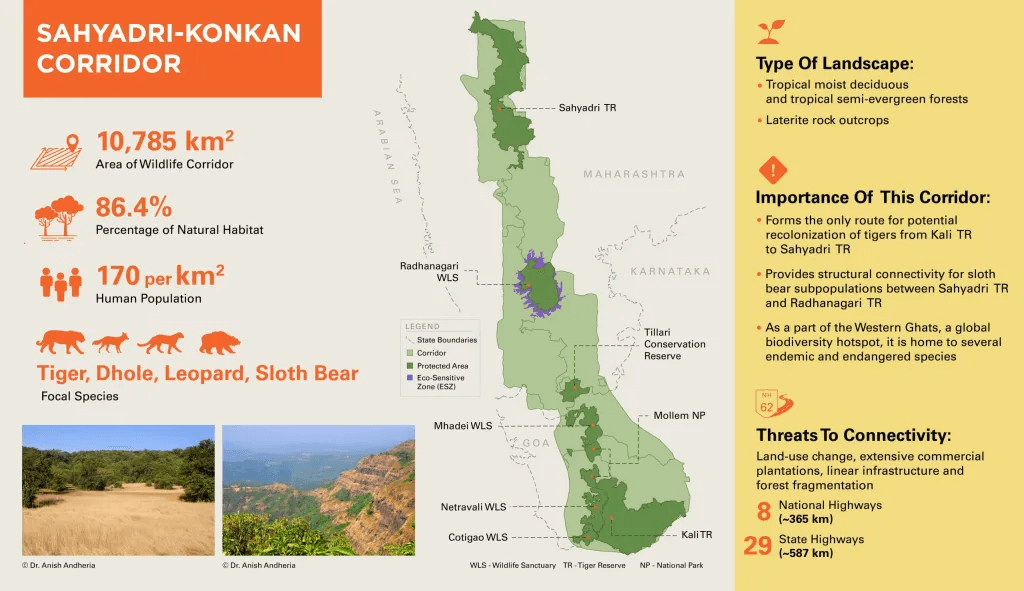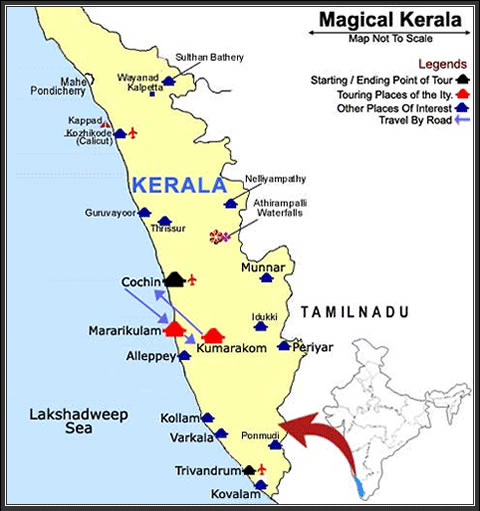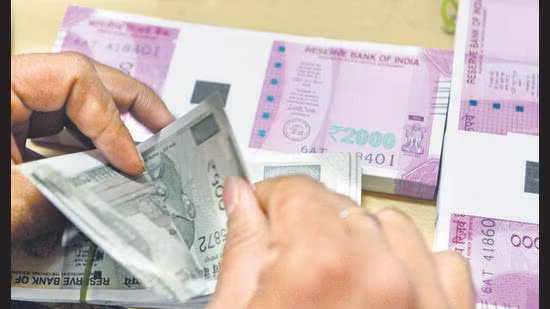- Courses
- GS Full Course 1 Year
- GS Full Course 2 Year
- GS Full Course 3 Year
- GS Full Course Till Selection
- Answer Alpha: Mains 2025 Mentorship
- MEP (Mains Enrichment Programme) Data, Facts
- Essay Target – 150+ Marks
- Online Program
- GS Recorded Course
- Polity
- Geography
- Economy
- Ancient, Medieval and Art & Culture AMAC
- Modern India, Post Independence & World History
- Environment
- Governance
- Science & Technology
- International Relations and Internal Security
- Disaster Management
- Ethics
- NCERT Current Affairs
- Indian Society and Social Issue
- NCERT- Science and Technology
- NCERT - Geography
- NCERT - Ancient History
- NCERT- World History
- NCERT Modern History
- CSAT
- 5 LAYERED ARJUNA Mentorship
- Public Administration Optional
- ABOUT US
- OUR TOPPERS
- TEST SERIES
- FREE STUDY MATERIAL
- VIDEOS
- CONTACT US
PLACES IN NEWS 14 NOVEMBER 2024
PLACES IN NEWS 14 NOVEMBER 2024
14-11-2024
Sahyadri Tiger Reserve (STR)

In November 2024, A new tiger was seen in the reserve, highlighting the continuing importance of STR as a habitat for tigers. Such sightings are a positive sign of the health of the tiger population and the reserve's role in wildlife preservation.
Overview:
- Location: The Sahyadri Tiger Reserve (STR) is located in the Sahyadri Ranges of the Western Ghats in Maharashtra, a UNESCO World Heritage site known for its rich biodiversity.
- Area: The reserve covers approximately 741.22 sq. km, making it a significant wildlife habitat in the northern part of the Western Ghats.
- Composition: STR was established by merging two protected areas in 2007:
- Koyna Wildlife Sanctuary (northern portion)
- Chandoli National Park (southern portion)
- The Shivsagar and Vasant Sagar reservoirs, created by the Koyna and Warana Rivers, occupy the central part of the reserve, adding a unique feature to the landscape.
Historical Significance:
- The region has a rich historical legacy, dating back to the era of the Maratha Empire. The area was strategically significant during the reign of Shivaji Maharaj, the first Maratha Emperor.
- Several forts, many built or captured by Shivaji, are scattered across the reserve, and the Bhavani Sword, an important symbol of Shivaji's power, is said to have been received by him from a temple in the region.
- This historical context adds cultural importance to the reserve beyond its ecological value.
Habitat and Landscape:
- The reserve is characterized by undulating terrain, steep escarpments along the western boundary, and rocky plateaus known as "Sadas," which are largely barren with sparse vegetation. These plateaus are unique to the Western Ghats and provide important habitats for specific wildlife.
- The region is known for its minimal anthropogenic influence, with low human intervention, allowing the vegetation to thrive in its natural state. The climax and near-climax vegetation types are found here, which means the ecosystem is largely undisturbed and in its natural, mature state.
- The Shivsagar and Vasant Sagar reservoirs create a unique ecological zone within the reserve, attracting a variety of bird species and providing water resources for both flora and fauna.
Flora:
- The forest cover in STR is diverse, with different vegetation types:
- Moist evergreen forests and semi-evergreen forests dominate the landscape, with areas of moist and dry deciduous forests.
- The area supports medicinal and fruit-bearing trees, as well as commercial hardwood species.
- Common plant species found in STR include:
- Anjani (Memecylon umbellatum)
- Jambhul (Syzygium cumini)
- Pisa (Actinodaphaone Angustifolia)
- These species contribute to both the ecological balance and the local economy, as many are used in traditional medicine.
Fauna:
- Carnivores: The reserve is home to a variety of carnivores, most notably the Bengal tiger, which is the flagship species of STR. It is the northernmost tiger habitat in the Western Ghats, an important ecological corridor for tigers. Other carnivores include the leopard, wild dog, wolf, and jackal.
- Herbivores: The region supports a range of herbivores, including several species of deer (such as Barking Deer and Sambar), as well as larger herbivores like the Indian Bison (Gaur) and the Sloth Bear.
- Mouse Deer, Giant Indian Squirrel, and Macaques are also present, contributing to the biodiversity.
- The combination of forest types, water bodies, and minimal human impact provides an ideal environment for these species to thrive.
Gutti Koya Tribals

On 13th November 2024, The National Commission for Scheduled Tribes (NCST) requested detailed reports from the Union Home Ministry, Chhattisgarh, Maharashtra, Andhra Pradesh, and Odisha on the status of the Gutti Koya tribals.
About the Gutti Koya Tribe:
-
Multi-racial and Multi-lingual Community:
The Gutti Koya are one of the few tribes in India that are multi-racial and multi-lingual. -
Geographical Distribution:
Concentrated in the states of Telangana, Andhra Pradesh, Chhattisgarh, and Odisha. - Language:
They speak Koya, a Dravidian language closely related to Gondi, with significant influence from Telugu.
Occupation & Economic Activities:
-
Agriculture:
The Gutti Koya practice Podu, a form of shifting cultivation, commonly used by tribal groups in forested areas. This method has been an ongoing issue between economic survival and environmental sustainability. -
Other Occupations:
- Animal husbandry
- Gathering minor forest produce
Festivals & Cultural Events:
-
Sammakka Saralamma Jatra:
- This is the most important fair for the Koya tribe.
- Held biannually, during the full moon of Magha Masam (January/February).
- Location: Medaram village, Mulug Taluk, Warangal District.
Tribal Status and Recognition:
- The Koya tribe holds Scheduled Tribe (ST) status in Chhattisgarh, but not in some of their migrated states like Telangana.
Social Structure & Family:
-
Sub-divisions (Gotrams):
All Koya belong to one of five sub-divisions called gotrams. They are born into a clan and cannot leave it. - Family Structure:
- Patrilineal and Patrilocal: Koya society follows a patrilineal system (descent traced through the father) and patrilocal residence (living with the husband's family after marriage).
- Nuclear Families: The predominant family structure is the nuclear family.
-
Marriage Practices:
Monogamy is prevalent among the Koya.
Bolgatty Waterdrome in Kochi

In November 2024, The Kerala Tourism Ministry is launching a seaplane service to enhance the tourism sector, operating from Bolgatty Waterdrome in Kochi.
About Seaplane:
-
Definition:
A seaplane is a class of aircraft designed to land, float, and take off on water. It combines the speed of an airplane with the functionality of a boat, allowing it to operate on both water and land. -
Characteristics:
Seaplanes are fixed-wing aircraft designed specifically for water-based takeoff and landing.
Types of Seaplanes:
-
Floatplanes:
- Design: Floatplanes have floats (buoyant structures) attached to the fuselage.
- Use: They rely entirely on water for takeoff and landing.
- Ideal Locations: Best suited for lakes, rivers, and coastal areas.
-
Flying Boats:
- Design: The entire hull of a flying boat is designed to float on water.
- Capability: They can carry larger passenger loads and take off/land in rougher water conditions compared to floatplanes.
Advantages of Seaplanes:
-
Flexibility:
Seaplanes can operate in both low-altitude flight and have access to both land and water, making them ideal for coastal surveillance. -
Surveillance Applications:
Seaplanes can be used for activities such as border control, investigations, and monitoring weather anomalies.
Must Check: Best IAS Coaching In Delhi
UPSC Prelims Result 2024 Out: Expected Cut Off & Other Details, UPSC Prelims 2024 Answer with Explanation, Daily Prelims Quiz, Daily Current Affairs, MONTHLY CURRENT AFFAIRS TOTAL (CAT) MAGAZINE, Best IAS Coaching Institute in Karol Bagh, Best IAS Coaching Institute in Delhi, Daily Mains Question Answer Practice, ENSURE IAS UPSC Toppers, UPSC Toppers Marksheet, Previous Year Interview Questions, UPSC Syllabus




